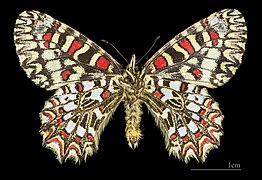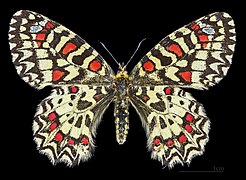Spanish Easter Luzei butterfly
| Spanish Easter Luzei butterfly | ||||||||||||
|---|---|---|---|---|---|---|---|---|---|---|---|---|

Spanish easter luce butterfly ( Zerynthia rumina ) |
||||||||||||
| Systematics | ||||||||||||
|
||||||||||||
| Scientific name | ||||||||||||
| Zerynthia rumina | ||||||||||||
| ( Linnaeus , 1758) |
The Spanish Festoon ( Zerynthia rumina ), also called Western Festoon, is a butterfly from the family of the swallowtail butterfly (Papilionidae). He is a food specialist whose caterpillars live exclusively on some species of pipe flowers ( Aristolochia ). The specific epithet is derived from Rumina , the protective goddess of suckling from Roman mythology .
features
The wingspan of the moth is about 46 to 50 millimeters. The basic color is usually pale yellow, but individual butterflies can also have an ocher-yellow basic color ("F. canteneri Staudinger"). The outer edge is predominantly colored black; however, the basic color is interrupted by two rows of arc spots. There are up to five black bars on the front edge, interrupted by sections in the basic color, perpendicular to the costal edge. The ridges are somewhat irregular and may contain white or red spots. A total of about three to five intense red spots are distributed over the front wing. They are used to distinguish between subspecies and forms. The underside of the forewings is slightly lighter in color than the upper side, especially the black border is strongly lightened. The drawing essentially corresponds to the drawing on the top. The hind wing also has a yellow base color. The two rows of arc spots in the black margin are more elongated in contrast to the forewing. In the inner part of the black border there is a row of red or yellow points (usually five). However, the black border can be reduced to two black wavy lines on some specimens; the field is kept here in the basic color. The underside of the hind wing is clearly lighter, usually light yellow or almost white. The outer wavy line is often bordered in red on the inside. A red spot can usually be seen at the base of the hind wings, especially in specimens from southern France . The body is colored gray-black overall. Laterally, however, it is interrupted by a series of trapezoidal spots (approx. Eight), and towards the dorsum there is another series of yellow or orange-red spots. Usually there are a few spots less than in the more ventral row of spots. Both sexes have the same wing markings, but the female is often larger.
The caterpillars are relatively compact with a dark blue to yellow basic color. They are about 53 millimeters long. Each thoracic segment has six bristle skin cones. In animals with a dark base color, they can be yellow or orange-red.
The doll is a special form of the belt doll. The belt thread does not encompass the middle of the body, but the area below the head or even only two forward-facing spikes at the tip of the head.
Similar Art
The Spanish Easter Luzei butterfly is very similar to the Osterluzei butterfly ( Zerynthia polyxena ). However, this usually has no red spots on the forewings. The range of the two species only overlaps in a small area on the French Mediterranean coast.
Occurrence
The main occurrence of the Spanish eagle butterfly is on the Iberian Peninsula (with the exception of the Asturian coastal region) and on the French Mediterranean coast. It is widespread in western North Africa ( Tunisia to Morocco ). However, the species occurs only locally, but can then be quite common. In North Africa the species rises up to 2100 meters, but is mostly found below 1600 meters. On the Iberian Peninsula and in southern France, the species can still occur at 1500 meters above sea level, but mostly deeper than 1000 meters. The moth can be found in warm, dry, mostly stony places between flower-rich meadows, bushes, bushes, the banks of dry river beds, but also in cultivated land, wherever the food plants of the caterpillars ( pipe flowers ) occur.
Way of life
The moths usually fly in one generation from late March to May. However, evidence of individual moths ranges from February to July. In North Africa, a second generation is formed in favorable places from August to October. The eggs are laid individually or in small groups of up to six eggs on the leaves of the food plants of the caterpillars. The caterpillar feeds on various types of pipe flowers ( Aristolochia ). In North Africa these are: little-veined easter lusks ( A. paucinervis ), A. fontanesii , round- bulbous easter lusks ( A. rotunda ) and possibly pale easter lusks ( A. pallida ). In Europe, on the other hand, there are Pistolochia Osterluzei ( A. pistolochia ), Round-bulbous Osterluzei ( A. rotunda ), Andalusian Pipe Flower ( A. baetica ) and Long Easter Luzei ( A. longa ) The caterpillars live hardly hidden on the leaves of the food plant, often the exposed to blazing sun. Pupation takes place on stems, on the bark of trees or under stones.
Subspecies
The possible subdivision of this species into subspecies is highly controversial in the literature. The one extreme ranges from up to seven subspecies on the Iberian Peninsula to the complete inclusion of all populations in a single species (without subspecies subdivision). A total of at least 11, but probably even more, names are available as subspecific taxa. Higgins & Riley (1978) subdivide the species into two subspecies, Zerynthia rumina rumina (Linnaeus, 1758) (Iberian Peninsula and southern France) and Zerynthia rumina ornatior (Blachier, 1905) (North Africa; from Tunisia to Morocco). E. Sabariego and J. Martinez, on the other hand, distinguish seven subspecies on the Iberian Peninsula alone (including the nominate subspecies): Zerynthia rumina australis (Esper, 1782), Zerynthia rumina cantabricae (Gomez-Bustillo, 1971), Zerynthia rumina castiliana (Rühl, 1892) , Zerynthia rumina catalonica (Sagarra, 1930), Zerynthia rumina isabelae (Sabariego & Huertas, 1976), Zerynthia rumina rumina (Linnaeus, 1758) and Zerynthia rumina transcastiliana (Sabariego, 1977) as well as some new forms. In contrast, Tolman & Lewington (1997) reunite the two subspecies that were eliminated for Europe and North Africa under the nominate form. The earlier subspecies ornatior is called f. (= forma) africana engraver, designated in 1907, a more recent synonym of ornatior Blachier, 1905. They do not go into the above work by Sabariego & Martinez (1991). JF Binagot and D. Lartigue (1998) again assume the existence of the North African subspecies; but it is referred to as Zerynthia rumina africana engraver, 1907. They also describe a new subspecies Zerynthia rumina tarrieri , which so far has only been found in a small area of the Anti-Atlas and the High Atlas in the Ameln Valley (Morocco). According to the molecular genetic studies by Nazari & Sperling (2007), the two subspecies africana and tarrieri show a difference of 2.5 percent in the investigated gene sequence of cytochrome oxidase I, a value that some species within the Parnassinae show. Both subspecies together are believed to be the sister group of all European populations. However, it was not possible to include all populations in the investigations that were previously proposed as infraspecific taxa. The examined populations show no significant differences, for example between the proposed "subspecies" castiliana Rühl, 1892, cantabricae Gomez-Bustillo, 1971 and the nominate subspecies. The populations in Portugal (ssp. Lusitanica Bryk) and southern France (ssp. Australis Esper) were not examined . The latest work currently only knows these three subspecies:
- Zerynthia rumina africana ( graver , 1907) (should probably be called Zerynthia rumina ornatior , since this name is older and has priority): The butterfly has strong, dark markings. On the hind wings there is a wide, black band in which the large spots are located. The red spot in Cu2-A is missing on the forewings.
- Zerynthia rumina rumina (Linnaeus, 1758)
- Zerynthia rumina tarrieri Binagot and Lartigue, 1998. The basic color varies from ocher yellow to light yellow. There are only two or often only one red spot on the forewing.
swell
Individual evidence
- ^ Arnold Spuler: The butterflies of Europe . tape 1 . E. Schweitzerbartsche Verlagbuchhandlung, Stuttgart 1908, p. 3 .
- ^ Lionel G. Higgins, Norman D. Riley: The butterflies of Europe and Northwest Africa . 1st edition. Paul Parey, Hamburg / Berlin 1978, ISBN 3-490-01918-0 , pp. 27 .
- ↑ Heiko Bellmann : The new Kosmos butterfly guide, butterflies, caterpillars and forage plants . Franckh-Kosmos, Stuttgart 2003, ISBN 3-440-09330-1 , p. 118 .
- ^ Steven P. Courtney, The Evolution of Egg Clustering by Butterflies and Other Insects. The American Naturalist, 123 (2): 276-281, Chicago 1984 ISSN 0003-0147
- ↑ Diego Jordano and Ginés Gomariz: Variation in phenology and nutritional quality between host plants and its effect on larval performance in a specialist butterfly, Zerynthia rumina. Entomologia Experimentalis et Applicata, 71 (3): 271-277, Amsterdam 1994 doi : 10.1007 / BF02426411
- ↑ Vazrick Nazari and Felix AH Sperling: Mitochondrial DNA divergence and phylogeography in western Palaearctic Parnassiinae (Lepidoptera: Papilionidae): How many species are there? Insect Systematics & Evolution, 38: 121-138, Copenhagen, 2007 ISSN 1399-560X
- ^ E. Sabariego and J. Martinez: Bionomia y distribucion geografica de Zerynthia rumina (Linnaeus, 1758) en Espana. Boletin de Sanidad Vegetal Plagas, 17 (4): 465-476, 1991 ISSN 0213-6910 PDF
- ↑ Tom Tolman, Richard Lewington: The butterflies of Europe and Northwest Africa . Franckh-Kosmos, Stuttgart 1998, ISBN 3-440-07573-7 .
- ↑ JF Binagot and D. Lartigue: Une nouvelle entité subspécifique de Zerynthia rumina (Linné, 1758) dans le sud-ouest marocain (Lepidoptera Papilionidae). Linneana Belgica 16: 323-334, Brussels 1998
literature
- JF Binagot and D. Lartigue: Une nouvelle entité subspécifique de Zerynthia rumina (Linné, 1758) dans le sud-ouest marocain (Lepidoptera Papilionidae). Linneana Belgica 16: 323-334, Brussels 1998
- Lionel G. Higgins, Norman D. Riley: The butterflies of Europe and Northwest Africa . 1st edition. Paul Parey, Hamburg / Berlin 1978, ISBN 3-490-01918-0 .
- Tom Tolman, Richard Lewington: The butterflies of Europe and Northwest Africa . Franckh-Kosmos, Stuttgart 1998, ISBN 3-440-07573-7 .
- Heiko Bellmann : The new Kosmos butterfly guide, butterflies, caterpillars and forage plants . Franckh-Kosmos, Stuttgart 2003, ISBN 3-440-09330-1 .
Web links
- Lepiforum e. V. Taxonomy and Photos
- www.schmetterling-raupe.de Photos
- Fauna Europaea
- Subspecies Zerynthia rumina tarrieri (French)






